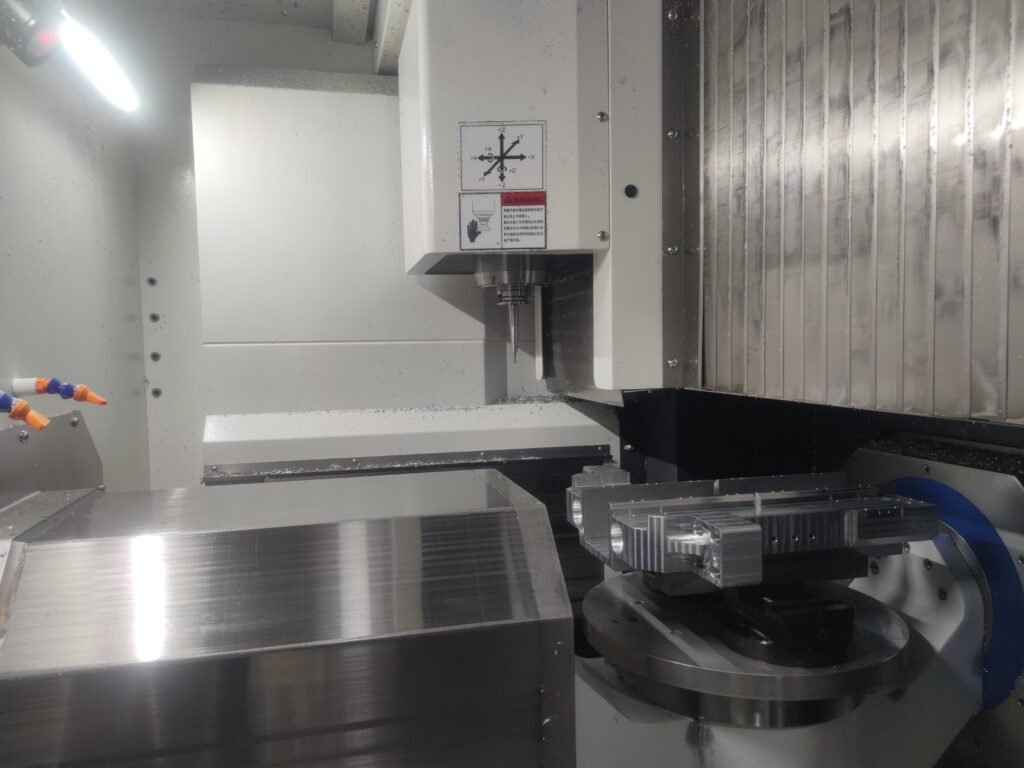In advanced manufacturing, five-axis machining centers represent the pinnacle of efficiency, precision, and complex-surface capability. However, simply owning a high-end five-axis machine does not guarantee long-term accuracy. Precision improvement is a system-level project that involves programming strategy, machining process planning, machine error compensation, and on-site execution.
This article integrates the latest research progress (2022–2025) across three major dimensions—programming, process optimization, and on-site execution—to provide a more systematic and validated roadmap for accuracy enhancement.
1. Programming Strategies: Accuracy Begins with the Toolpath

1.1 Toolpath Smoothing and Curvature Continuity
Recent studies emphasize that fluctuations in curvature during five-axis toolpaths cause sudden acceleration/deceleration, leading to tracking errors and surface defects. Methods based on G²/G³ continuity or space of master–slave movement (SMM) have shown significant improvements in toolpath smoothness and machining accuracy.
Practical recommendations:
- Apply smoothing algorithms before post-processing.
- Avoid sharp corners or abrupt directional changes.
- Review the acceleration/jerk curve via simulation to identify instability points.
1.2 Tool Axis Vector Optimization
Excessive fluctuations in the tool-axis vector remain one of the hidden killers of five-axis precision. Recent advancements in angle-constrained interpolation and orientation-smoothing algorithms show that stabilizing tool-axis transitions significantly reduces dynamic errors and improves surface consistency.
Practical recommendations:
- Gradually transition tilt/lead angles.
- Avoid over-aggressive collision-avoidance positions.
- Make full use of CAM’s intelligent tool-axis smoothing features.
2. Process Optimization: Precision Built Through Craftsmanship
2.1 Layered Machining and Allowance Strategy
Industrial practice and academic studies consistently support the “roughing–semi-finishing–finishing” layering strategy. Keeping a uniform finishing allowance of 0.5–1.0 mm helps release internal stress and prevents deformation during the final step.
2.2 Tooling, Toolholders, and Cutting Parameters
Recent research highlights the importance of high-rigidity toolholders (hydraulic or heat-shrink) and proper tool geometry/coating in reducing runout and maintaining stability. Cutting strategies based on constant cutting load / constant engagement have been shown to improve surface finish and dimensional repeatability during complex contour machining.
2.3 RTCP (Rotation Tool Center Point) Verification and Correction
RTCP is the foundation of spatial accuracy in five-axis machining. Recent studies propose advanced methods for verifying RTCP trajectories (e.g., figure-eight test paths) and improving compensation effectiveness. These methods showed significant reductions in RTCP-induced deviations.
Practical recommendations:
- Verify RTCP regularly using dynamic test paths.
- Incorporate RTCP calibration into preventive maintenance.
- Ensure accurate RTCP activation in the NC program.
3. On-Site Execution: Where Every Detail Affects Precision

3.1 Thermal Error: Latest Developments in Data-Driven Online Compensation
Recent review papers confirm that thermal drift remains the largest source of error in precision machining. Hybrid physical + data-driven (machine learning / deep learning) compensation models are becoming the most effective approach for real-time thermal error control. Low-latency surrogate models are increasingly viable in industrial applications.
Practical recommendations:
- Deploy multi-point temperature and strain sensors.
- Train hybrid models offline and implement online inference.
- Gradually build an integrated closed-loop thermal compensation system.
3.2 Geometric Error Modeling and Tolerance Optimization
Recent studies apply sensitivity analysis and multi-objective optimization (e.g., NSGA-II) to optimize tolerances and reduce geometric error influence from the design stage. Combining this with modern error compensation algorithms significantly enhances final machining accuracy.
3.3 Real-Time Detection and Closed-Loop Compensation
Recent research demonstrates notable improvements (sometimes 80–90% depending on configuration) in RTCP and geometric accuracy when integrating real-time detection methods with compensation algorithms.
Recommended practice:
- Establish a closed-loop chain:
RTCP Test → Deviation Identification → Compensation → Verification - Archive measurement data to build an internal knowledge base.
4. A Practical Implementation Roadmap (Research → Process → Workshop)
- Toolpath smoothing & optimization (G²/G³, SMM-based corner smoothing).
- RTCP dynamic verification using figure-eight or specialist test trajectories.
- Thermal error modeling using hybrid ML + physical modeling and online compensation.
- Geometric tolerance optimization during design using multi-objective algorithms.
- Establish a periodic QA cycle covering:
Thermal → Geometric → RTCP → Toolpath → Machining Results.
Conclusion
In summary, achieving high-precision five-axis machining requires a comprehensive and systematic approach. Beyond advanced equipment, precision depends on optimized process planning, real-time compensation technologies, stable thermal control, toolpath optimization, and rigorous quality verification. By integrating the latest research findings—such as enhanced RTCP algorithms, adaptive thermal error compensation, dynamic error modeling, and AI-assisted monitoring—manufacturers can significantly improve machining consistency and capability. As five-axis applications continue to expand into aerospace, medical devices, and high-performance engineering components, the combination of cutting-edge technology and refined process management will remain the key to sustaining long-term precision and competitiveness.
